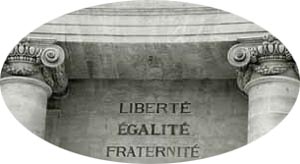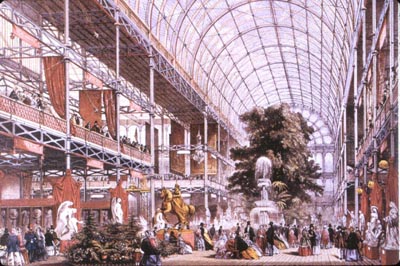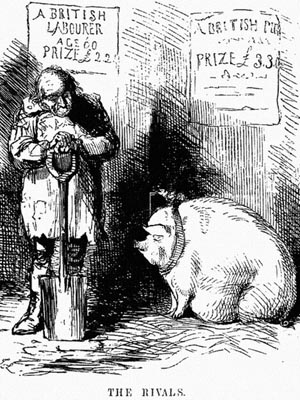 |
Socio-Political Issues
Liberalism, Socialism, Feudalism - I
Discussing Liberal & Socialist Democracies
Plinio Corrêa de Oliveira
In previous meetings, I had the opportunity of speak about the two more known forms of democracy: the socialist democracy and the individualist, normally called liberal democracy.
The latter is the one that considers that "liberty, equality, fraternity" - the motto of the French Revolution that forms the base of the Modern State - should be implemented in a regime where all power comes from the people, who should be completely free, with as little interference of the State as possible.
On the contrary, the socialist democracy believes that this motto cannot be properly executed in the liberal democracy because once one gives liberty to the people, inequalities necessarily appear. Since the qualities of men are unequal - some become richer than others, more famous etc - they transmit these consequences to their children through inheritance and advantages, which also give rise to inequality of families, blood, formation and money. To avoid this, the socialists defend that an authoritarian regime is needed to ensure equality and oblige all have the same level.

The famous motto of the French Revolution reveals itself to be contradictory
|
The conclusion is that the motto of the French Revolution is contradictory. It wants to accomplish equality along with liberty, but this is not possible. Either equality is sacrificed to have liberty, or vice-versa. From this contradiction the different positions of Liberalism and Socialism come.
In the 19th century, these two ways of conceiving democracy raised many discussions and polemics that even resulted in civil wars. In passing, it is curious to notice how partisans of both opinions were not able to see these shortcomings and contradictions. Later in this series, I hope to analyze the balanced position of a Catholic democracy without any of these revolutionary myths. Now, let us continue with our study of these modern regimes.
Principles of a liberal democracy
What is the position of liberal democracy? These are its three fundamental principles:
- First, man is naturally good, and when we give him liberty, he will do good.
- Second, nature is also good, so when a good man acts over a good nature the fruits are necessarily good.
- Third, the end of the State is to promote the common good, but the common good comprises that of each of its citizens. Since no one knows better than each citizen what his particular good is, when the State gives each one liberty, it promotes the common good in the best way possible. Then, liberty to each individual is equal to the common good and happiness for society.
Someone could object that this reasoning is wrong, since when complete liberty is given to a people, there are conflicts of interests, which can easily lead to crime.
To this objection, the liberal would answer: This is true, and thence the function of the State consists in preventing injustices and criminal acts from taking place. Once arrangements are made to prevent crime, liberty can be given to all to lead their lives the way they want. Thus, the State exists mainly to avoid and punish injustices through its judicial system and to enforce the law through its police. The old liberals used to explain this in this way: The State exists to maintain order and good customs in society. Outside of this, it should do nothing to interfere in the life of its citizens.
Therefore, for the State to encourage commerce, run schools or promote culture and the arts would be for it to go beyond its task.
Examples of some principal liberal States
The three main examples of liberal States that had applied these principles with excellent results used to be the United States, England and Switzerland. For the liberal, the principal proof that his system works is to point to the great prosperity that came with its application, principally in the United States.
In the 19th century, when these regimes were being discussed and tested, the U.S. was in a phase of great progress. The country had a relatively small population with an enormous appetite for gains, which made its inhabitants race after gold, oil and the country’s natural resources to become rich. The result is that U.S. became the wealthiest nation in the world.

The splendor of the industrial revolution concealed tragic failures - Above the Crystal Palace in London, 1851 |
Except for the few laws enforced by the judicial system and the police, everyone in the U.S. could do whatever he wanted. To repress crime, the police went after the bandits; and often a cowboy would become the sheriff to hunt the criminal. Favorite themes of North American literature and cinema were cowboys and police because its public life gravitated chiefly around this.
Seeing this, the liberals said: The United States is proof that when man is free, he does well, prospers, and can do whatever he wants; each man understands his own interest better than anyone else.
They would also add: Since nature is good, the best way to exploit it is to give man full liberty to do so - a free agriculture, livestock, commerce, industry - or there would be a shock in nature. To the natural goodness of man corresponded the goodness of nature.
You can understand that this progress confirming the doctrine raised much admiration in the 19th century. This was all the more so as it was also practiced by England, a powerful industrial nation in an industrial century. During a large part of that century, England was fundamentally liberal. You know that England was the queen of the seas and had the largest empire on earth. At that time, world economics was influenced much more by London than by Washington.
The two most liberal nations on earth were, therefore, models of progress. This represented an important factor for the expansion of the liberal model of democracy.
The third successful liberal nation was a small one, Switzerland, but ordered and running like a clock. So, the liberals argued: You see, here is a liberal nation that brings together peoples of three different languages - German, French and Italian. These peoples do not have problems among themselves because they were given liberty. Liberty is the formula for society.
Disasters start
These arguments, however, only lasted for a while. It started to become clear - especially in England and the U.S. – that the very pressure of the rapid economic development fostered by liberty was generating absurd situations.

Machines in the factories empoverished the workers and pushed down the salaries |
The first of these situations occurred in the employer-worker relationship. In it, the weaker party is the worker, who relies on his weekly salary to provide for his family. The employers had the tendency to oppress the workers, demanding much work and paying as little as possible to increase their profits.
This situation generated Europe’s first great social crisis. You know that machines are introduced into factories to make the production faster and cheaper. As these machines were introduced, more and more workers were dismissed and were impoverished. The employers, however, showed no concern for their social situation. They were only concerned about making more money to pay for the machines and earn the highest profit possible.
This, of course, generated a large number of unemployed workers in the labor market. The employers, instead of helping those people, lowered the salaries for those who still had jobs. In addition, work conditions were poor, unhealthy, and insecure. This shaped a situation of clear oppression by employers, a terrible situation that spread from England to all the countries that had industry.
As a consequence of this crisis, part of that working force emigrated to North and South America. This flow of emigration continued as long as those countries could receive the displaced workers. But, there is no country in the world that can indefinitely receive immigrants. In a well-organized country, there are many conditions that needed to be met to receive others, so that both the country and the immigrants will benefit. Thus, as each country met its quota of immigrants, the doors closed.
The conclusion was that this kind of democracy required a review. The liberal democrats reached this conclusion: It is not enough to give liberty; it is necessary to place certain limits on liberty or these disasters will continue. In this case, the law must establish the salaries and protect the workers.
The employers complained: How can higher salaries be given to men who work in clothing factories than to those who labor in coal mines? If this happens, the miners will leave the mines to work in the clothing industry. Even if they both receive the same salaries, the miners will also leave since their work is much harder. The result was that the leaders of the clothing industries and coal mines naturally started to influence politics to elect representatives who would make laws favoring their own branches of business.
So, one abuse generated another. Industry started to use its money to buy the political representatives, which resulted in the government - which according to the myth is autonomous – actually becoming in considerable part an extension of industry. Next, based on these 'bought' representatives, the State approved laws that would apply to the entire country.
A vicious circle, therefore, was established, whereby the excess of liberty in the liberal democracy generated by its own dynamism some of the same evils of the socialist democracy: State intervention and political corruption.
Continued

Posted March 5, 2012

Related Topics of Interest
 Socialism Exploits Liberalism’s Flaws - Part 2 Socialism Exploits Liberalism’s Flaws - Part 2
 The Fiasco of Socialism & Basics on Catholic Authority - Part 3 The Fiasco of Socialism & Basics on Catholic Authority - Part 3
 The Principle of Subsidiarity - Part 4 The Principle of Subsidiarity - Part 4
 Subsidiarity & Feudalism - Part 5 Subsidiarity & Feudalism - Part 5
 The Medieval Family & Subsidiarity - Part 6 The Medieval Family & Subsidiarity - Part 6
 The Role of Local Authorities & Customs - Part 7 The Role of Local Authorities & Customs - Part 7
 Universal Suffrage Is ‘Madness’ Universal Suffrage Is ‘Madness’

Related Works of Interest
|
|
Social-Political | Hot Topics | Home | Books | CDs | Search | Contact Us | Donate

© 2002- Tradition in Action, Inc. All Rights
Reserved
|
 |
|